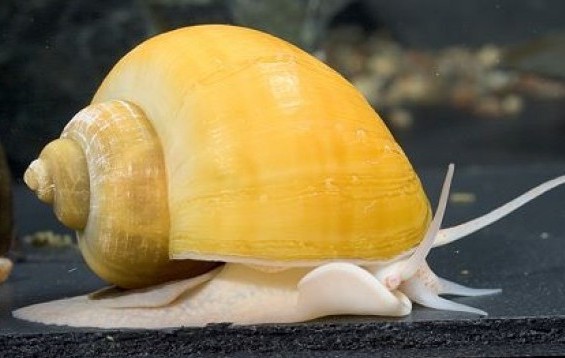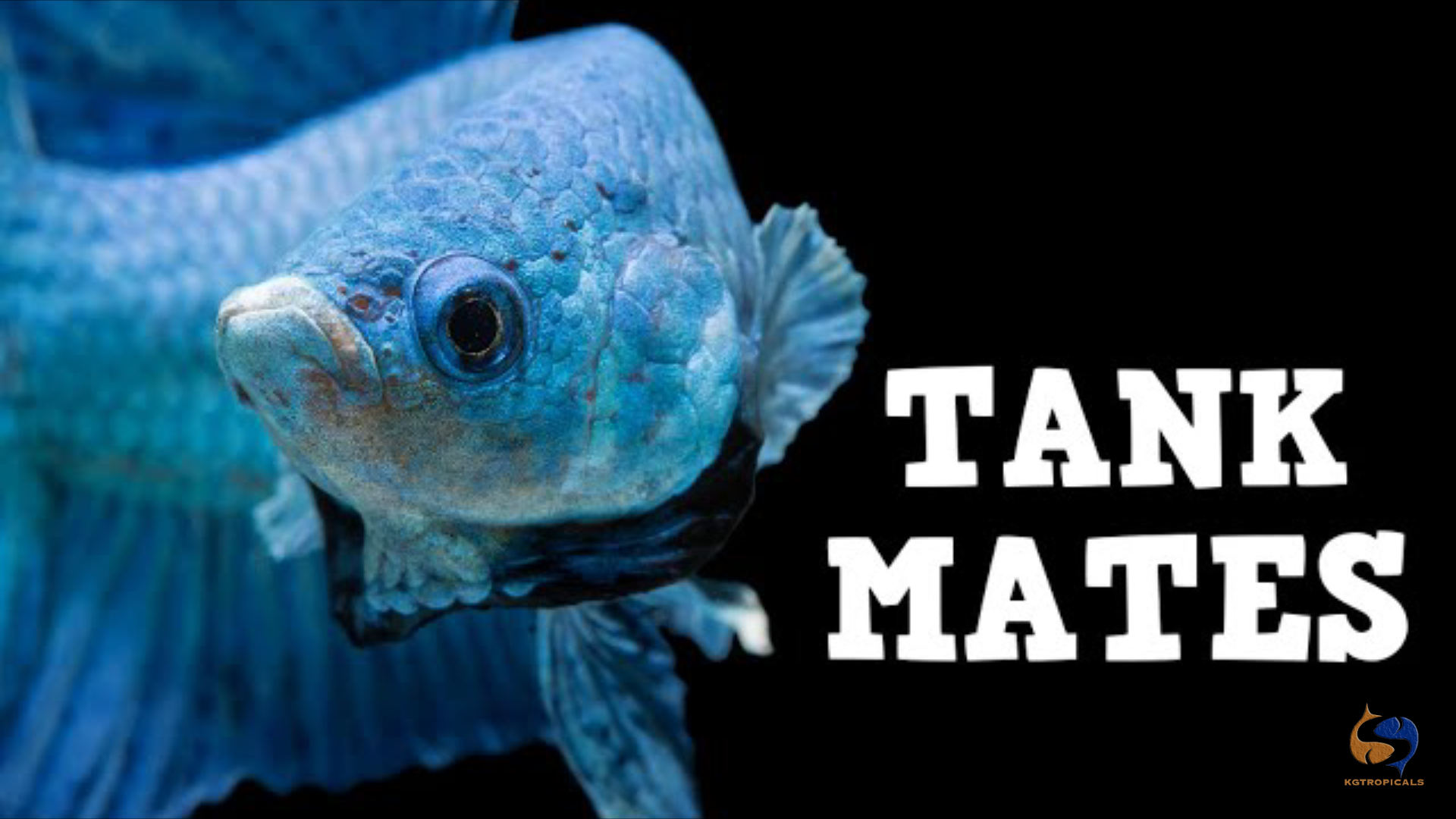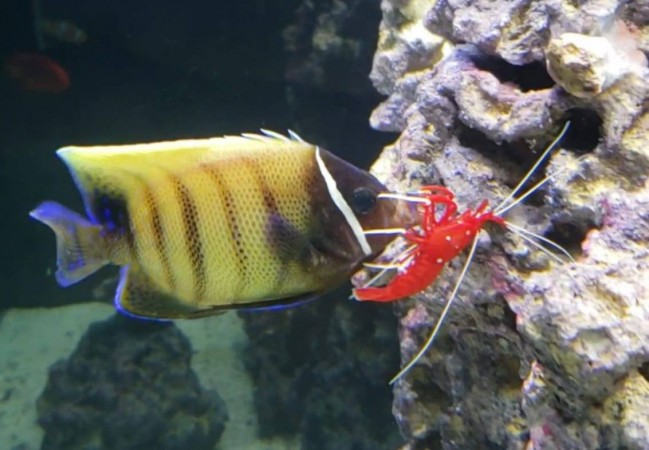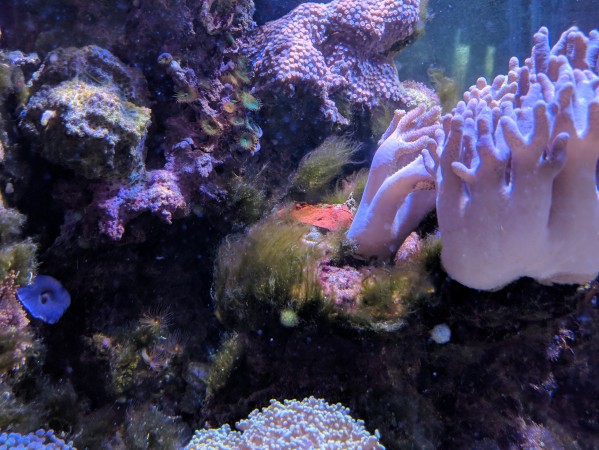- Name:
Gold Mystery Snail
- Family: Ampullariidae
- Species: Snail
- Scientific Name: Pomacea sp


General info about Gold Mystery Snail
These snails can also be named as a Gold Mystery Snail, a Golden Mystery Snail, a Golden Inca Snail, a Golden Snail, a Yellow Snail, an Inca Snail or by some other name. The Gold Mystery Snail is one of about 120 species belonging to the Ampullariidae family. The Ampullariidae family name is also sometimes referred to as Pilidae. The most visible characteristic of snails belonging to the Pomacea genus is the siphon. When needed, this siphon will extend out to the water surface allowing the snail to breathe while submerged. The siphon in this genus is typically longer than the length of the snail's body. They have an “operculum” which they use to close their shell, enabling them to survive out of water for some time.
A Gold Mystery Snail color is deep yellow and gold with a creamy white body, head, and foot. A Gold Snail has several orange dots sprinkled across it head just above and around its mouth. Orange dashes appear on its siphon and orange rings appear around its eyes. Its creamy white and orange color combination, combined with its yellow-gold shell, can really stand out in an aquarium. Especially in tanks with rich green plants, a black substrate, and a black background.
A Gold Mystery Snail lifespan is about one year, or maybe more if conditions are good and the snail is lucky. That said, it is not uncommon for them to die shortly after being added to a tank. Death may be attributable to the stress of being transported from the store. The shift in water parameters between store tank water and the water in the new environment can be an issue as well. A dead snail should be removed from a tank as soon as possible to avoid Ammonia spikes or other water problems.
In its natural habitat, the Gold Mystery Snail remains hidden in submerged vegetation during the day and becomes more active at night, sometimes leaving the water to search for fresh vegetation. Two to four inches of open air space above the waterline in the aquarium is required as this snail needs open air to breathe.
They are peaceful by nature preferring a calm environment with non-aggressive tank mates. Gold Snails have no means to attack other aquarium inhabitants and can only use its shell and operculum to defend itself. They should not be housed with any other animals that would like to make a meal of it.
A Gold Mystery Snail can be very active during times when the tanks lights are on, steadily traveling throughout the aquarium on the hunt for food, interesting places to explore, or a quiet place to take a break. A Gold Inca Snail can also be very active when the tank lights are off. Inca Snails are often busy feeding at night in complete darkness.
A Gold Snail can do well in a wide range of aquarium water conditions. Staying within the tropical community fish tank range is a good start. Water Temperature should between 68 – 82 Degrees Fahrenheit with 7.2 – 7.5 pH level. In terms of actual aquarium size, like many other snails, a Gold Mystery Snail can thrive in small established tanks, like 5 or 10-gallon aquariums, or in larger established tanks as well. Whichever is chosen, make sure the basic rules against overstocking followed. The tank should be established and stable. A Gold Mystery Snail should be kept in aquarium water on the hard side, with sufficient calcium levels to maintain healthy shell growth. The shell whorl should be smooth-ish in texture from the apex to just above the mantel. The shell should not be thin or have excessive cracks or pits. Thin, cracked or pitted shells can indicate a calcium deficiency, so periodic calcium supplements may be necessary.
Another care issue is the hazard of a strong filter intake. They may be drawn to an intake to explore and feed. The danger for the snail is that it may get its head stuck in the intake. Between the water current and the snail swelling up, it may be unable to pull itself out and it could easily die. Trying to rescue a trapped Inca Snail may be even more harmful. Tempting to pull the snail from the water intake and kill it by accident. The better practice is to try to avoid the problem altogether by placing sponge pre-filters over strong water intakes in advance of trouble.
Hobbyists often add a bunch of snails to a tank as an “aquarium cleaning crew”. But snails tax the bio-load of the tank like other living organisms. Keep in mind that a Gold Mystery Snail is just like any other tank inhabitant. Snails feed on their aquatic world and they produce waste into it.
Gold Mystery Snail Diet & Nutrition
As a scavenger, this snail can be a ferocious eater when feeding. Adept at scouring hard surfaces for edible material, a Gold Snail seems to enjoy eating soft algae growing on aquarium glass, decorations, rocks and other hard surfaces like slow growing plant leaves. Inca Snails don’t seem to be interested in Green Spot Algae growing on a glass, as it is probably too hard for them to ingest.
In addition to edible matter that grows naturally, a Gold Inca Snail should be fed supplements of fish food, bottom feeder pellets, and algae wafers. It is not a good idea to think that snails can survive solely on the naturally growing matter as the snail may starve. In addition to store-bought food, a Gold Mystery Snail may also like supplements of washed soft blanched vegetables such as leaf lettuce, iceberg lettuce, cucumber, carrots, canned green beans or green zucchini squash. Spinach is especially beneficial for the snails as it can provide them with valuable calcium. Gold mystery snails tend to enthusiastically eat a lot of fresh vegetables. Experiment with different vegetables to see what the snail is interested in. Generally, if a snail is not interested in the vegetable after one day, I take it out. Leaving uneaten vegetables in the tank too long is not good for water quality. The same goes for overfeeding with fish food and pellets.
Determining Sex of Gold Mystery Snail
Members of the Ampullariidae family are either male or female. The sex of snails can be determined if they are the same age, have been kept in the same environment, and are fed the same foods in which case, then the female will be larger than the male.
Breeding & Spawning Gold Mystery Snail
They lay their eggs above the water line generally at night, so some open humid space should be left in the top part of the tank for them to access for attaching their eggs. Between 10 to 600 eggs can be laid on the water surface. If the eggs make it, in a couple of weeks you should have tiny snails. You can try to feed them crushed flake foods (separate them from the main tank) or let them graze on any growing algae already in the tank.
Common Diseases with Gold Mystery Snail
Most issues are related to irregular shell growths due to improper or poor water quality. Missing tentacles are usually the result of a fish sampling them. The tentacles may or may not grow back depending on the situation. If the snail is isolated from fish and kept in good water conditions it may grow back.
Caution with Gold Mystery Snail
Ammonia and Nitrite levels should be at 0 ppm. Along these lines, Nitrate levels need to be kept in check with regular partial water changes. And be wary of tank medications, treatments, and plant fertilizers as they can be harmful or fatal to a Gold Snail. The same goes for additives containing copper. Snails are sensitive to medications containing copper or insecticides. Take care to remove them from tanks before treating them with any chemicals containing these substances.
Gold Mystery Snails may try to get out of the tank, so it is the to keep the tank well covered. An escaped snail can die from drying out.
Acclimating Gold Mystery Snail
Gold Snail care issue often overlooked is how the snail is added to a tank. An upside-down snail may have a hard time turning over when coming out of its shell. They will open its operculum and extend its foot reaching for a hard surface like gravel or substrate. If the snails’ foot cannot reach a hard surface, the snail may be unable to turn over and right itself. And if too much time passes, the snail could die.
Original Detail
| Name | Species | Family | Scientific Name | More Detail | Added by |
|---|---|---|---|---|---|
| Gold Mystery Snail | Snail | Ampullariidae | Pomacea sp | These snails can also be named as a Gold Mystery Snail, a Golden Mystery Snail, a Golden Inca Snail, a Golden Snail, a Yellow Snail, an Inca Snail or by some other name. The Gold Mystery Snail is one of about 120 species belonging to the Ampullariidae family. The Ampullariidae family name is also sometimes referred to as Pilidae. The most visible characteristic of snails belonging to the Pomacea genus is the siphon. When needed, this siphon will extend out to the water surface allowing the snail to breathe while submerged. The siphon in this genus is typically longer than the length of the snail's body. They have an “operculum” which they use to close their shell, enabling them to survive out of water for some time. A Gold Mystery Snail color is deep yellow and gold with a creamy white body, head, and foot. A Gold Snail has several orange dots sprinkled across it head just above and around its mouth. Orange dashes appear on its siphon and orange rings appear around its eyes. Its creamy white and orange color combination, combined with its yellow-gold shell, can really stand out in an aquarium. Especially in tanks with rich green plants, a black substrate, and a black background. A Gold Mystery Snail lifespan is about one year, or maybe more if conditions are good and the snail is lucky. That said, it is not uncommon for them to die shortly after being added to a tank. Death may be attributable to the stress of being transported from the store. The shift in water parameters between store tank water and the water in the new environment can be an issue as well. A dead snail should be removed from a tank as soon as possible to avoid Ammonia spikes or other water problems. In its natural habitat, the Gold Mystery Snail remains hidden in submerged vegetation during the day and becomes more active at night, sometimes leaving the water to search for fresh vegetation. Two to four inches of open air space above the waterline in the aquarium is required as this snail needs open air to breathe. They are peaceful by nature preferring a calm environment with non-aggressive tank mates. Gold Snails have no means to attack other aquarium inhabitants and can only use its shell and operculum to defend itself. They should not be housed with any other animals that would like to make a meal of it. A Gold Mystery Snail can be very active during times when the tanks lights are on, steadily traveling throughout the aquarium on the hunt for food, interesting places to explore, or a quiet place to take a break. A Gold Inca Snail can also be very active when the tank lights are off. Inca Snails are often busy feeding at night in complete darkness. A Gold Snail can do well in a wide range of aquarium water conditions. Staying within the tropical community fish tank range is a good start. Water Temperature should between 68 – 82 Degrees Fahrenheit with 7.2 – 7.5 pH level. In terms of actual aquarium size, like many other snails, a Gold Mystery Snail can thrive in small established tanks, like 5 or 10-gallon aquariums, or in larger established tanks as well. Whichever is chosen, make sure the basic rules against overstocking followed. The tank should be established and stable. A Gold Mystery Snail should be kept in aquarium water on the hard side, with sufficient calcium levels to maintain healthy shell growth. The shell whorl should be smooth-ish in texture from the apex to just above the mantel. The shell should not be thin or have excessive cracks or pits. Thin, cracked or pitted shells can indicate a calcium deficiency, so periodic calcium supplements may be necessary. Another care issue is the hazard of a strong filter intake. They may be drawn to an intake to explore and feed. The danger for the snail is that it may get its head stuck in the intake. Between the water current and the snail swelling up, it may be unable to pull itself out and it could easily die. Trying to rescue a trapped Inca Snail may be even more harmful. Tempting to pull the snail from the water intake and kill it by accident. The better practice is to try to avoid the problem altogether by placing sponge pre-filters over strong water intakes in advance of trouble. Hobbyists often add a bunch of snails to a tank as an “aquarium cleaning crew”. But snails tax the bio-load of the tank like other living organisms. Keep in mind that a Gold Mystery Snail is just like any other tank inhabitant. Snails feed on their aquatic world and they produce waste into it. |
PalaciosAn |
Changed by users
| Submitted Date | Submitted By | Status | Action |
|---|





